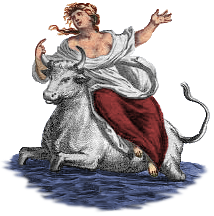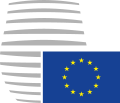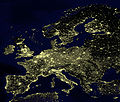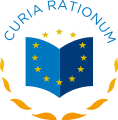Portal:European Union
Introduction
The European Union (EU) is a supranational political and economic union of 27 member states that are located primarily in Europe. The Union has a total area of 4,233,255 km2 (1,634,469 sq mi) and an estimated total population of over 449 million. The EU has often been described as a sui generis political entity combining the characteristics of both a federation and a confederation. Containing 5.8% of the world population in 2020, EU member states generated a nominal gross domestic product (GDP) of around US$16.6 trillion in 2022, constituting approximately one sixth of global nominal GDP. Additionally, all EU states except Bulgaria have a very high Human Development Index according to the United Nations Development Programme. Its cornerstone, the Customs Union, paved the way to establishing an internal single market based on standardised legal framework and legislation that applies in all member states in those matters, and only those matters, where the states have agreed to act as one. EU policies aim to ensure the free movement of people, goods, services and capital within the internal market; enact legislation in justice and home affairs; and maintain common policies on trade, agriculture, fisheries and regional development. Passport controls have been abolished for travel within the Schengen Area. The eurozone is a group composed of the 20 EU member states that have fully implemented the economic and monetary union and use the euro currency. Through the Common Foreign and Security Policy, the union has developed a role in external relations and defence. It maintains permanent diplomatic missions throughout the world and represents itself at the United Nations, the World Trade Organization, the G7 and the G20. Due to its global influence, the European Union has been described by some scholars as an emerging superpower. In 2012, the EU was awarded the Nobel Peace Prize. The United Kingdom became the only member state to leave the EU, in 2020; ten countries are aspiring or negotiating to join it. (Full article...) Selected article The Kingdom of Belgium is a country in northwest Europe bordered by the Netherlands, Germany, Luxembourg and France and is one of the founding and core members of the European Union. Belgium has a population of over ten million people, in an area of around 30,000 square kilometres (11,700 square miles). Straddling the cultural boundary between Germanic and Romance Europe, Belgium is linguistically divided. It has two main languages: 59% of its population, mainly in the region Flanders, speak Dutch; French is spoken by 40% of the entire Belgian population. Less than 1% of the Belgian people, around 70,000 citizens, live in the German-speaking Community in the east of Wallonia. This linguistic diversity often leads to political and cultural conflict and is reflected in Belgium's complex system of government and political history. Belgium derives its name from the Latin name of the most northern part of Gaul, Gallia Belgica, named after a group of mostly Celtic tribes, Belgae. Historically, Belgium has been a part of the Low Countries, which also include the Netherlands and Luxembourg and used to cover a somewhat larger region than the current Benelux group of states. From the end of the Middle Ages until the seventeenth century, it was a prosperous centre of commerce and culture. From the sixteenth century until the Belgian revolution in 1830, the area at that time called the Southern Netherlands, was the site of many battles between the European powers. More recently, Belgium was a founding member of the European Union, hosting its headquarters, as well as those of many other major international organisations, such as NATO. Selected pictureThe Colosseum in Rome, Italy, at dusk. Although it is now in a severely ruined condition, the Colosseum has long been seen as an iconic symbol of Imperial Rome and is one of the finest surviving examples of Roman architecture.
Did you know?...that "Nocturne" is the Eurovision Song Contest winner with the fewest words, the Norwegian language original having only 25?  ...that the Eastgate Clock (pictured) in Chester is the second most photographed timepiece in the United Kingdom, after Big Ben? ...that "Kinek mondjam el vétkeimet?" received three perfect scores at the start of voting in the Eurovision Song Contest 1994 before ultimately coming in fourth, making Hungary the only debuting nation to lead the voting? Selected cityAmsterdam, capital city of the Netherlands, lies on the banks of two bodies of water, the IJ bay and the Amstel river. Founded in the late 12th century as a small fishing village on the banks of the Amstel, it is now the largest city in the country and is a financial and cultural centre. In 2006, the population of the municipality proper was 741,329; the population of the official Greater Amsterdam area is approximately 1.5 million, but the real agglomeration is estimated at 2 to 2.5 million. Amsterdam is also one of the core urban centres of the greater metropolitan area called Randstad (English: "Ring City") which encompasses other Dutch cities and has a population of over 7.5 million. Amsterdam has one of the largest historic city centres in Europe, dating largely from the 17th century. At this time, a series of concentric, semi-circular canals (grachten) were dug around the old city centre. Along the canals houses and warehouses were built. The canals still define Amsterdam's layout and appearance today. Amsterdam is famous for its free-spirited liberalism, diversity and tolerance. General imagesThe following are images from various European Union-related articles on Wikipedia.
TopicsFeatured contentFeatured articles
Featured lists
Featured contentGood articles
CategoriesRelated portalsAssociated WikimediaThe following Wikimedia Foundation sister projects provide more on this subject:
Discover Wikipedia using portals |

































































